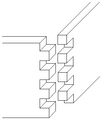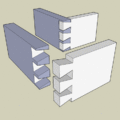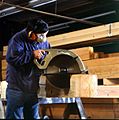Woodworking joints facts for kids
Joinery is a cool part of woodworking! It's all about how you connect different pieces of wood together to build something strong and lasting. Think of it like putting together a giant puzzle, but with wood!
Long ago, people learned how to join wood without using metal nails or sticky glue. They used the natural strengths of wood itself. Different kinds of joinery are used for different projects. For example, the way you join wood to build a house is different from how you'd make a small wooden toy. But some ideas are similar!
Wood is super strong when you push or pull it along its natural lines, called the grain. But it's not as strong if you try to break it across the grain. Wood also changes size a tiny bit depending on how much moisture is in the air. It expands when it's humid and shrinks when it's dry. This change is very small along the grain, but it can be quite noticeable across it.
Cool Types of Wood Joints
There are many clever ways to join wood. Each type of joint has a special purpose, making sure the wood pieces fit together perfectly and hold strong. Here are some examples:
-
Mortise and tenon joint uses a "tongue" (tenon) that fits into a "hole" (mortise).
Joinery Around the World
Two of the most famous traditions for joinery come from Japan and Europe. Japanese woodworkers, especially, became masters of joinery. They created hundreds of different joints! Their furniture and buildings were often put together without any glue or nails. This meant the pieces could be taken apart and put back together again, which was very clever!
Images for kids









